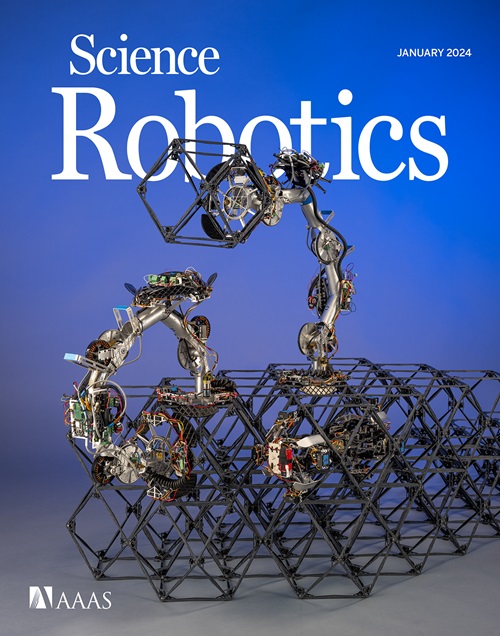An agile monopedal hopping quadcopter with synergistic hybrid locomotion
IF 27.5
1区 计算机科学
Q1 ROBOTICS
引用次数: 0
Abstract
Nature abounds with examples of superior mobility through the fusion of aerial and ground movement. Drawing inspiration from such multimodal locomotion, we introduce a high-performance hybrid hopping and flying robot. The proposed robot seamlessly integrates a nano quadcopter with a passive telescopic leg, overcoming limitations of previous jumping mechanisms that rely on stance phase leg actuation. Based on the identified dynamics, a thrust-based control method and detachable active aerodynamic surfaces were devised for the robot to perform continuous jumps with and without position feedback. This unique design and actuation strategy enable tuning of jump height and reduced stance phase duration, leading to agile hopping locomotion. The robot recorded an average vertical hopping speed of 2.38 meters per second at a jump height of 1.63 meters. By harnessing multimodal locomotion, the robot is capable of intermittent midflight jumps that result in substantial instantaneous accelerations and rapid changes in flight direction, offering enhanced agility and versatility in complex environments. The passive leg design holds potential for direct integration with conventional rotorcraft, unlocking seamless hybrid hopping and flying locomotion.具有协同混合动力的敏捷单足跳四旋翼飞行器
大自然中不乏通过融合空中和地面运动实现卓越机动性的例子。从这种多模式运动中汲取灵感,我们推出了一种高性能混合跳跃和飞行机器人。拟议的机器人将纳米四旋翼飞行器与被动伸缩腿无缝集成,克服了以往依靠站立阶段腿部驱动的跳跃机制的局限性。根据确定的动力学原理,设计了一种基于推力的控制方法和可拆卸的主动空气动力学表面,使机器人能够在有位置反馈和无位置反馈的情况下进行连续跳跃。这种独特的设计和驱动策略能够调整跳跃高度并缩短站立阶段的持续时间,从而实现敏捷的跳跃运动。在跳跃高度为 1.63 米时,机器人的平均垂直跳跃速度为每秒 2.38 米。通过利用多模式运动,该机器人能够在飞行过程中进行间歇跳跃,从而产生巨大的瞬时加速度并迅速改变飞行方向,在复杂环境中提供更高的灵活性和多功能性。被动腿设计具有与传统旋翼机直接集成的潜力,可实现无缝混合跳跃和飞行运动。
本文章由计算机程序翻译,如有差异,请以英文原文为准。
求助全文
约1分钟内获得全文
求助全文
来源期刊

Science Robotics
Mathematics-Control and Optimization
CiteScore
30.60
自引率
2.80%
发文量
83
期刊介绍:
Science Robotics publishes original, peer-reviewed, science- or engineering-based research articles that advance the field of robotics. The journal also features editor-commissioned Reviews. An international team of academic editors holds Science Robotics articles to the same high-quality standard that is the hallmark of the Science family of journals.
Sub-topics include: actuators, advanced materials, artificial Intelligence, autonomous vehicles, bio-inspired design, exoskeletons, fabrication, field robotics, human-robot interaction, humanoids, industrial robotics, kinematics, machine learning, material science, medical technology, motion planning and control, micro- and nano-robotics, multi-robot control, sensors, service robotics, social and ethical issues, soft robotics, and space, planetary and undersea exploration.
 求助内容:
求助内容: 应助结果提醒方式:
应助结果提醒方式:


